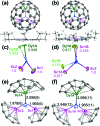Magnetization relaxation in the single-ion magnet DySc2N@C80: quantum tunneling, magnetic dilution, and unconventional temperature dependence
- PMID: 29671443
- PMCID: PMC5933001
- DOI: 10.1039/c8cp01608a
Magnetization relaxation in the single-ion magnet DySc2N@C80: quantum tunneling, magnetic dilution, and unconventional temperature dependence
Abstract
Relaxation of magnetization in endohedral metallofullerenes DySc2N@C80 is studied at different temperatures, in different magnetic fields, and in different molecular arrangements. Magnetization behavior and relaxation are analyzed for powder sample, and for DySc2N@C80 diluted in non-magnetic fullerene Lu3N@C80, adsorbed in voids of a metal-organic framework, and dispersed in a polymer. The magnetic field dependence and zero-field relaxation are also studied for single-crystals of DySc2N@C80 co-crystallized with Ni(ii) octaethylporphyrin, as well as for the single crystal diluted with Lu3N@C80. Landau-Zener theory is applied to analyze quantum tunneling of magnetization in the crystals. The field dependence of relaxation rates revealed a dramatic dependence of the zero-field tunneling resonance width on the dilution and is explained with the help of an analysis of dipolar field distributions. AC magnetometry is used then to get access to the relaxation of magnetization in a broader temperature range, from 2 to 87 K. Finally, a theoretical framework describing the spin dynamics with dissipation is proposed to study magnetization relaxation phenomena in single molecule magnets.
Figures











References
-
- Popov A. A., Yang S., Dunsch L. Chem. Rev. 2013;113:5989–6113. - PubMed
-
- Shinohara H. and Tagmatarchis N., Endohedral Metallofullerenes: Fullerenes with Metal Inside, John Wiley & Sons, Ltd, 2015.
-
- Endohedral Metallofullerenes: Basics and Applications, ed. X. Lu, L. Echegoyen, A. L. Balch, S. Nagase and T. Akasaka, CRC Press, 2014.
-
- Endohedral Fullerenes: From Fundamentals to Applications, ed. S. Yang and C.-R. Wang, World Scientific, 2014.
-
- Yang S., Wei T., Jin F. Chem. Soc. Rev. 2017;46:5005–5058. - PubMed
Grants and funding
LinkOut - more resources
Full Text Sources
Other Literature Sources
Miscellaneous

